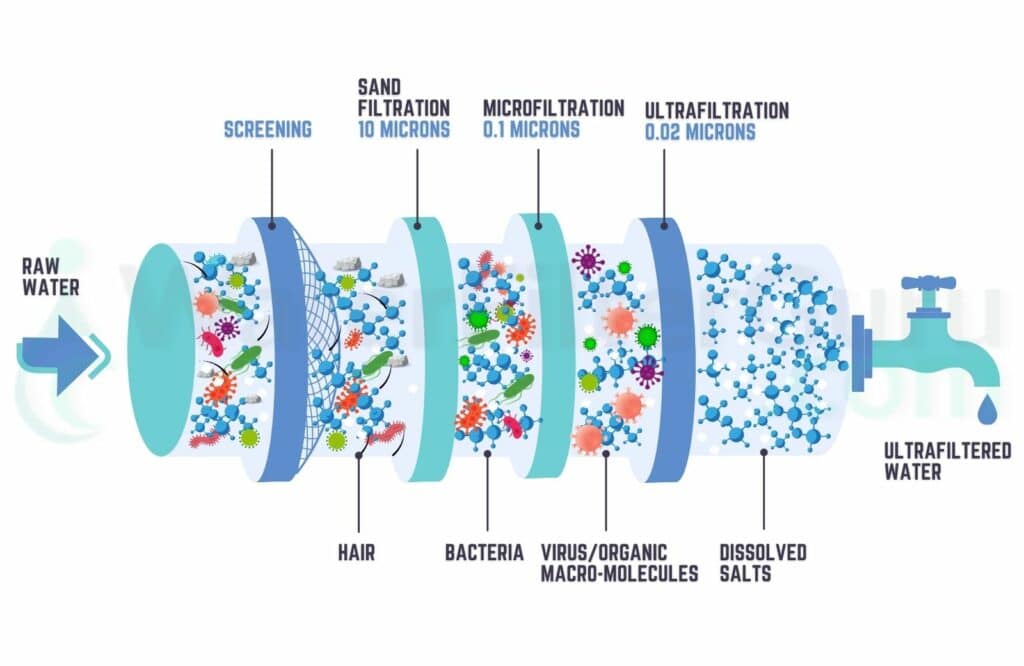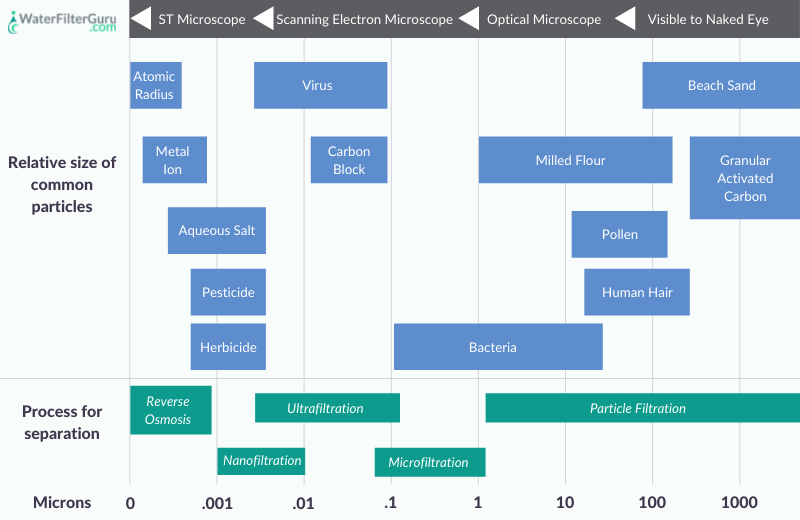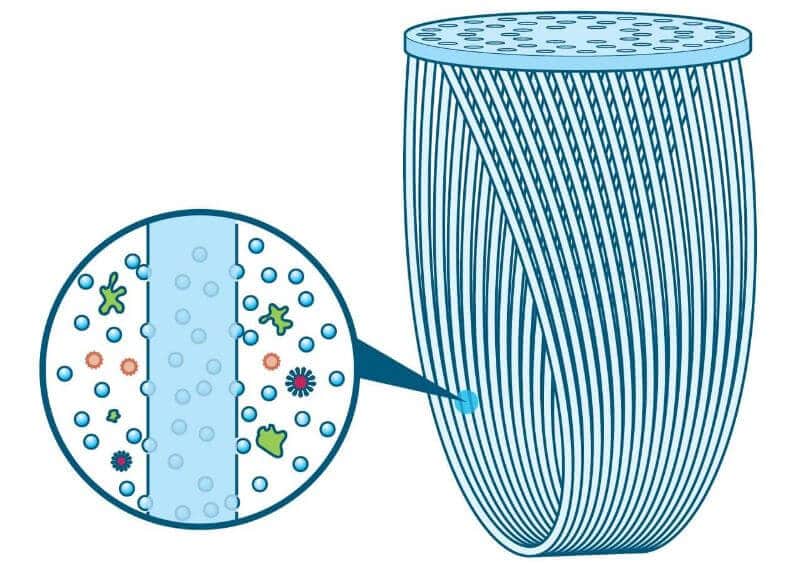Today’s water filtration market is bursting with effective, high-quality purification solutions. It can be difficult to know which option is for you, especially when there are so many to choose from.
It’s wise to be aware of your choices before you make a purchasing decision, so you know for certain that you’ve made the right choice for your budget and requirements. This guide will focus on ultrafiltration, a purification process that offers a particularly impressive range of benefits.
Table of Contents
🤔 How Does Ultrafiltration (UF) Work?
What is ultrafiltration? It’s a membrane filtration process that sends water through a hollow fiber membrane at a high pressure.
Only water particles and a select few impurities are small enough to pass through the membrane, which consists of thousands of tiny pores. As a result, contaminants that are larger than water particles (high molecular weight solutes) are left behind on one side of the membrane, while smaller particles (low-molecular weight solutes) pass through the membrane pores to the other side.

Ultrafiltration drinking water systems are connected up to the cold water line beneath your kitchen sink. The pressure of the water promotes a good flow of water through the ultrafiltration (UF) membrane, ensuring thorough contaminant removal. This type of microfiltration system doesn’t have a tank for water storage and doesn’t produce wastewater. It usually requires its own dedicated faucet to maintain water quality on its journey into your drinking glass.
It’s easy to confuse ultrafiltration with reverse osmosis, because both water treatment methods are very similar. However, reverse osmosis offers a more thorough filtration process than ultrafiltration. Alongside the hollow fiber membrane, a reverse osmosis system also sends water through a number of filtering cartridges, including a sediment cartridge and an activated carbon filtering cartridge.
🔎 What Does Ultrafiltration Remove from Water?
Ultrafiltration is ideal for targeting smaller contaminants that slip through most water filters, thanks to its tiny pore size of 0.1-0.01 microns. This mechanical microfiltration system can filter water all the way down to 0.025 microns.
Time for a quick science lesson: a good way to describe the effectiveness of ultrafiltration treatment is to look at its “molecular weight cut-off” (MWCO).
The most simplified definition of the molecular weight cut-off is that 90% of high-molecular weight solids that are heavier than the MWCO will be unable to pass through the membrane.
You can utilize ultrafiltration to effectively remove bacteria and some viruses from drinking water, as well as some organic suspended solids, turbidity, and some (but only a small percentage of) natural salts and minerals.

🚰 When Are UF Ultrafiltration Systems Used?
Ultrafiltration systems have a number of industrial uses, such as in the food and beverage industry, and in the treatment of water used in factories and other manufacturing establishments. This type of water treatment can also be carried out at home.
You can purchase point-of-use ultrafiltration membranes that can be installed underneath your kitchen sink. They can be used to provide clean drinking water from your faucet, and offer a fast, simple solution compared to the majority of the water filtration methods available today.
✅ Benefits of UF Membranes
No Chemicals Required
To eliminate microorganisms from water, a chemical disinfectant is usually required. However, because the ultrafiltration membrane pore size is small enough to get rid of pathogens, it makes for an effective chemical-free alternative.
Reduced Operating Costs
Ultrafiltration membranes have an affordable up-front price and don’t cost much to maintain. You’ll need to replace the membrane periodically, but this filtration solution typically has a lifespan of 5-7 years.
Removes Microorganisms
It’s hard to find many systems that are capable of removing pathogens such as bacteria. A UF membrane, however, can effectively remove these contaminants – though some viruses might remain.
No Water Waste
Around 95% of water is used during ultrafiltration, as some water is used for backwashing the system. Because effluent water is recycled, this purification treatment is one of the more environmentally friendly options available.
Compact Size
Ultrafiltration membranes are relatively compact, making them less of an invasive installation in a home or for business use. They don’t typically take up too much under-sink space, though this depends on whether they’re combined with additional filtration solutions, like pre-filtering cartridges or RO units, for example.

❌ Disadvantages of UF
Frequent Backwashing & Cleaning May Be Required
If your water source is particularly contaminated, you might need to clean and backwash your ultrafiltration (UF) membrane frequently.
Membrane Replacement Required
As well as cleaning and backwashing the ultrafiltration membrane, you’ll also need to replace it as recommended by the manufacturer. Failing to replace the membrane will result in the membrane being unable to do its job properly, and contaminants may not be effectively removed.
Pre-Filter Highly Recommended
Some UF membranes come with their own pre-filter, which is used before the membrane for the removal of larger particles that could damage the screen. Having a pre-filter means you’ve got something else to maintain, and these filters need replacing frequently, too.
Can’t Remove Dissolved Contaminants
Perhaps the biggest setback of an ultrafiltration system is that it can’t be used to treat dissolved contaminants in water. You would require a conventional activated carbon filtering cartridge alongside the system if you wanted to treat dissolved contaminants too. Additionally, while ultrafiltration solutions can effectively remove bacteria, they may not be able to completely remove viruses.
🆚 UF Membrane vs Reverse Osmosis
Both reverse osmosis and ultrafiltration are two processes that use high-pressure membrane filtration technology, which is why they’re often confused with one another.
However, both processes of microfiltration have their own standout features that enable them to produce slightly different results.
- A reverse osmosis system uses a semipermeable membrane, which has a smaller pore size of around 0.0001 microns and removes a very high concentration of contaminants in drinking water.
- An ultrafiltration (UF) membrane filtration uses a hollow fiber membrane design which prevents organic suspended solids and microscopic materials from being able to feed or pass through the membrane.
Reverse osmosis is a more thorough process for a broad range of contaminant removal, eliminating more than 99.9% of contaminants during clean water production, including lead and VOCs (volatile organic compounds).
An ultrafiltration system, on the other hand, doesn’t remove dissolved solids and salts from water; only substances that are suspended (or those that float on the surface) in the water. However, what makes this filtration treatment better than the majority of water filters is that it works on a microscopic level.
You can find out more about the differences between ultrafiltration and reverse osmosis processes in our ultrafiltration vs reverse osmosis comparison guide.
🆚 UF Membrane Vs Nanofiltration
There’s another type of water treatment that can remove smaller substances from water, called nanofiltration. Like ultrafiltration, nanofiltration can filter out protozoa, bacteria and viruses in water. It can also filter organic matter, salt and natural minerals.
However, nanofiltration isn’t capable of eliminating particle types that can dissolve in water. Nanofiltration typically uses a membrane with a pore size of 0.001 microns. A nanofiltration unit removes slightly more particle ions than a UF membrane, but this technology isn’t quite as capable as reverse osmosis in terms of contaminants removed.
